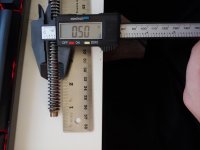I'm no fabricator or machinist, this is just something I find myself needing to create for a project I must complete. Please reference picture below. The metal rod in the picture has what I can only describe as very largely gapped machine threads. That black plastic piece threads into a tubular housing (with the finer threads at the top) but the large threads from that rod are what go inside that black plastic piece to move it up and down.
What I need help with is identifying (if even but roughly) what "thread" this is and where I might locate a metal "nut" that I can use as a basis for some fabrication I'm planning on undertaking. Many thanks in advance!
EDIT: I should have mentioned, I have already ordered a thread/pitch gauge to accurately measure what size threads this thing is to be sure I am able to order what I need. I just don't even know where to start searching for this, I'm assuming there are some industry specific terms I'm unaware of that would greatly help my search.

What I need help with is identifying (if even but roughly) what "thread" this is and where I might locate a metal "nut" that I can use as a basis for some fabrication I'm planning on undertaking. Many thanks in advance!
EDIT: I should have mentioned, I have already ordered a thread/pitch gauge to accurately measure what size threads this thing is to be sure I am able to order what I need. I just don't even know where to start searching for this, I'm assuming there are some industry specific terms I'm unaware of that would greatly help my search.




